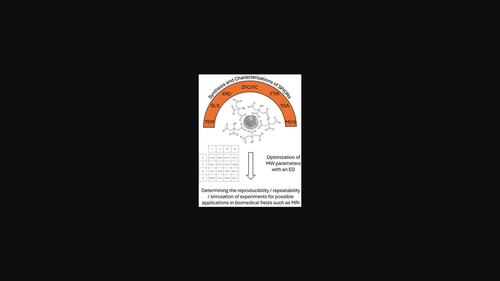用微波工艺一步制备超顺磁性氧化铁纳米粒子:利用实验设计优化微波参数
IF 2.7
4区 材料科学
Q3 CHEMISTRY, PHYSICAL
引用次数: 0
摘要
超顺磁性氧化铁纳米粒子(SPIONs)是一种纳米粒子,被广泛应用于电池、生物医学等领域......为了获得这种纳米粒子,目前有多种技术,如共沉淀、热分解、溶胶-凝胶工艺等,但这些技术各有优点(在水介质中合成、高结晶度、高单分散性)和缺点(使用有机溶剂、尺寸分布大、结晶度差)。这项工作的目标是合成用于生物医学应用的 SPIONs(例如作为核磁共振成像的造影剂):SPIONs 应在水介质中稳定、单分散、具有良好的结晶性和磁性。为了实现这一目标,需要采用微波工艺。然而,目前还没有任何研究描述了微波参数对纳米粒子合成的影响。本研究旨在确定微波的最佳条件,以获得用于核磁共振成像的理想 SPIONs。为此,我们进行了实验设计,通过不同的表征技术(透射电子显微镜、动态光散射、X 射线衍射、热重分析、磁性表征)来确定这些参数。根据这些表征的不同结果,确定了微波的最佳条件,并利用表面响应对所有实验进行了模拟。本文章由计算机程序翻译,如有差异,请以英文原文为准。

One Step Superparamagnetic Iron Oxide Nanoparticles by a Microwave Process: Optimization of Microwave Parameters with an Experimental Design
Superparamagnetic iron oxide nanoparticles (SPIONs) are nanoparticles used in a lot of applications such as batteries, and biomedical, … To obtain these nanoparticles, several techniques exist such as coprecipitation, thermal decomposition, sol–gel process but they have some advantages (synthesis in a water media, high crystallinity, high monodispersity) and disadvantages (using an organic solvent, large distribution of size, poor crystallinity). The goal of this work is to synthesize SPIONs for biomedical applications (for example as a contrast agent for the MRI): SPIONs should be stable in an aqueous media, monodisperse, and have good crystallinity and magnetic properties. To achieve this result, a microwave process is carried out. However, any study describes the microwave parameter on the synthesis of the nanoparticles. This work offers to determine the best conditions of the microwave to obtain ideal SPIONs for MRI. For this, an experimental design is carried out to determine these parameters thanks to different techniques of characterization (Transmission Electronic Microscopy, Dynamic Light Scattering, X-ray diffraction, Thermogravimetric Analysis, magnetic characterizations). With the different results of these characterizations, the best conditions of the microwave are determined, and a simulation of all experiments is realized with a surface response.
求助全文
通过发布文献求助,成功后即可免费获取论文全文。
去求助
来源期刊

Particle & Particle Systems Characterization
工程技术-材料科学:表征与测试
CiteScore
5.50
自引率
0.00%
发文量
114
审稿时长
3.0 months
期刊介绍:
Particle & Particle Systems Characterization is an international, peer-reviewed, interdisciplinary journal focusing on all aspects of particle research. The journal joined the Advanced Materials family of journals in 2013. Particle has an impact factor of 4.194 (2018 Journal Impact Factor, Journal Citation Reports (Clarivate Analytics, 2019)).
Topics covered include the synthesis, characterization, and application of particles in a variety of systems and devices.
Particle covers nanotubes, fullerenes, micelles and alloy clusters, organic and inorganic materials, polymers, quantum dots, 2D materials, proteins, and other molecular biological systems.
Particle Systems include those in biomedicine, catalysis, energy-storage materials, environmental science, micro/nano-electromechanical systems, micro/nano-fluidics, molecular electronics, photonics, sensing, and others.
Characterization methods include microscopy, spectroscopy, electrochemical, diffraction, magnetic, and scattering techniques.
 求助内容:
求助内容: 应助结果提醒方式:
应助结果提醒方式:


